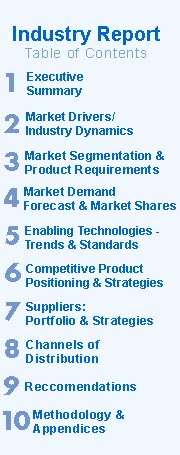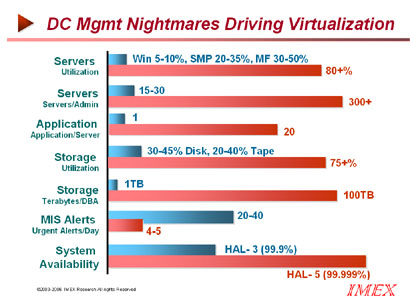| NexGen Data Centers: The Rise of Virtualization Click on Executive Summary and Table of Contents for additional information. |
||||||||||||||||
| The Need for Consolidation |
|
|||||||||||||||
| Most of CFOs had a shocking observation at the end of dot com decade IT infrastructure investments put in place were yet to achieve the financial objectives promised by CIOs nor was the expected boost in productivity anywhere in sight. The reason Web growth brought in its wake a myriad of new applications such as load balancing, caching, firewalls, security, proxy caching etc. Many of these applications were put on low cost windows servers with the resulting servers sprawl without much control. In the meantime as business grew in late 90s, it demanded more computing power in almost each department fueling a mushroom of application/DB servers. These in turn demanded additional storage, additional data center facilities, increase in power and cooling, IT support and finally IT staff. The IT costs spiraled out of control and out of synch with business growth.
|
||||||||||||||||
| The CEOs finally laid down the dictum to do more with less in the early 2000's challenging economic environment. Improving the productivity of IT assets became the top priority for CIOs, knowing that the average CPU was running around 25% capacity while stranded direct-attached storage was being utilized below 50% in many large companies. The rise in energy costs mushroomed as fuel prices rose from $25 to $70/barrel. Therein lay the seeds of consolidation of data centers to end the sprawl, increase the utilization of resources already in place, and virtualization rose to the occasion. |
|
|||||||||||||||
| Enterprise Virtualization Enterprise Virtualization combines server, storage, application and desktop virtualization technologies to create a more flexible, cost-effective infrastructure, eases the deployment of servers, applications, and client systems, and paves the way to dynamically manage your IT environment. Running multiple virtual servers (also called virtual machines) can fully exploit a physical server's compute potential and provide a rapid response to shifting datacenter demands. Unlike grid technologies, which require architectural changes, server virtualization lets firms easily encapsulate applications into containers that can be moved between physical servers priming the use of advanced technologies such as automated configuration and distributed load management. The Market Virtual servers are now ready to go beyond the early adopter stage to become full mainstream in the next year or two. Driving the push for virtualization is cost reduction through server consolidation, dynamic provisioning, and disaster recovery. Virtualization Technology usage in large and medium sized companies, grew from 29% in 2005 to 40% in 2006. Expect 45% of all new servers purchased in 2007 to be virtualized, according to IMEX Research estimates. This adds up to an estimated worldwide market for Virtualization software to grow from $790 million in 2006 to $1.75 billion in 2009 a hefty growth of 32% cagr. Goals of Enterprise Virtualization
Issues to be Resolved The proliferation of virtualization technologies across enterprise networks is exploding, and IT professionals are beginning to realize that in actual practice the ability to manage virtual applications, and integrate them into the physical layers is more of a challenge that many first thought. In fact, many of the early adopters are now convinced that these breakthrough technologies are creating as many systems management headaches as they solve, including: • Databases may not yet be ready to be virtualized due to performance issues involved. Futures Expect to see server and system vendors move toward standardized frameworks in virtualization. IMEX Research envisions that virtual machine interfaces will move from the current vendor-specific model to a standardized topology allowing customers to dynamically switch between multiple vendors, further streamlining data center consolidation, especially during mergers and acquisitions. Expect moving OS instances and application instances from server to server based on manual administration decisions or rudimentary policies, allowing IT managers to run their data centers more efficiently. 2007 will be a busy year in the virtualization field Microsoft and Xensource will elbow their products into the market to challenge the dominance of VMware which held a market share of 86% in 2006 and is rapidly expanding its domain from a simple physical server o multiple virtual servers to improve x86 usage utilization into a broad systems infrastructure based behemoth with a plethora of tools to virtualize all IT resources from PCs to Grids . Report IMEX Research's Industry Report on State of the Virtualization Industry addresses the needs of Vendors (Semiconductors, Boards, Subsystem and System Manufacturers), Go-to-Market Direct and Indirect Channels (System Integrators, VARs and Distributors), End Users by Vertical Industries and Investors/VCs in pointed ways: For the end users the report provides: • Prescriptive guidance based on experiences of early adopters sharing their experiences of implementing and managing virtualization For the vendors , the report provides a comprehensive look at the current and evolving industry and the opportunities, pitfalls and outlook on virtualization encompassing 10 chapters • Executive Summary |
||||||||||||||||
| Click on the following for additional information or go to http://www.imexresearch.com IMEX Research, 1474 Camino Robles San Jose, CA 95120 (408) 268-0800 http://www.imexresearch.com |
||||||||||||||||



